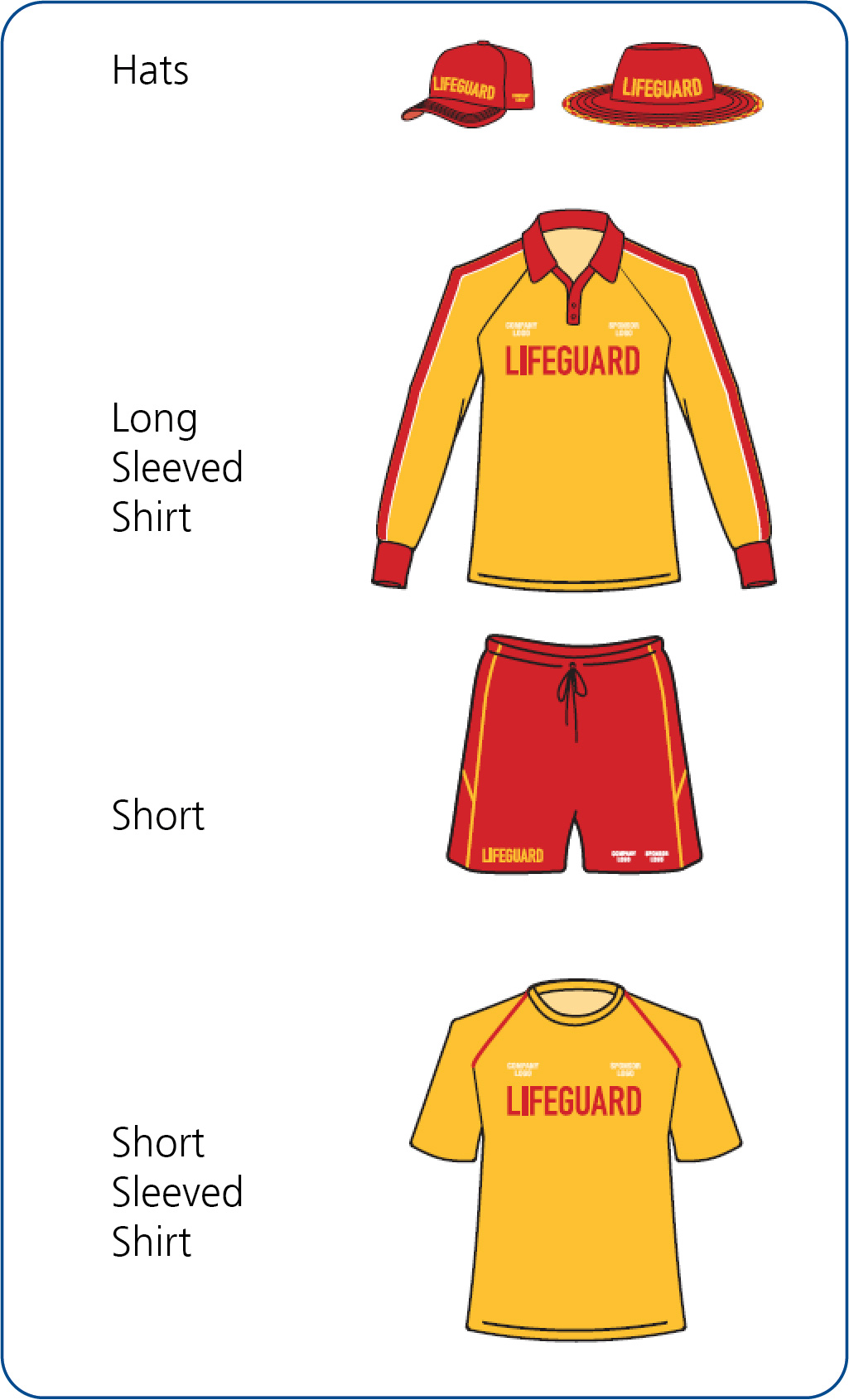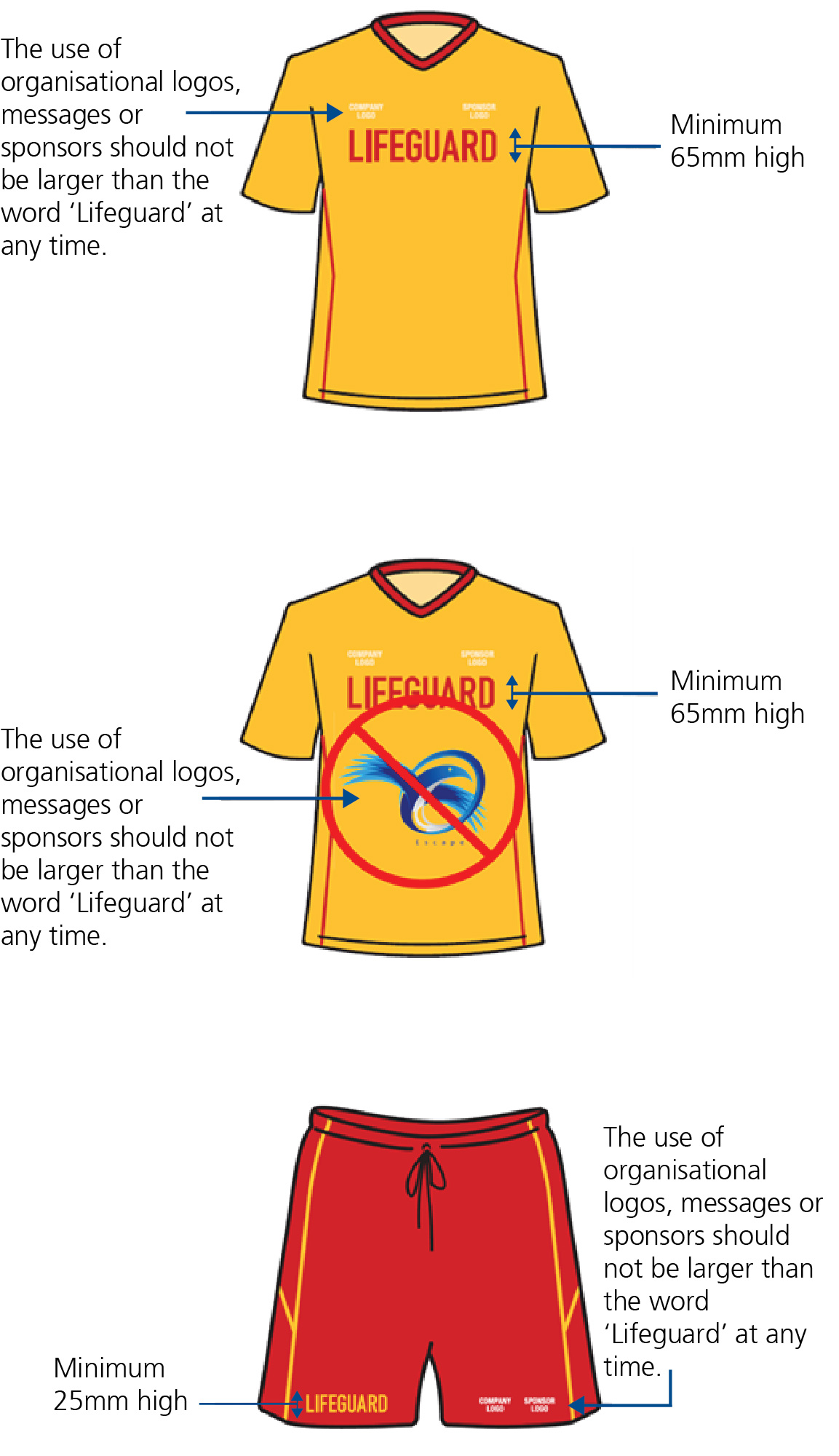SV13 - Pool Lifeguard Uniform
| Issue Date | Effective Date | Version |
|---|---|---|
| 20/01/2018 | 01/09/2019 | 1.0 |
Purpose
To provide guidance on Lifeguard uniforms and personal protection equipment.
Description
The owner or operator of an Aquatic Facility should ensure that Lifeguards wear a visible, identifiable and consistent uniform to help promote international consistency and recognition.
Lifeguarding is a profession that exists throughout the world. Lifeguards are called upon to provide safety services at a range of water environments that include swimming pools, beaches, lakes, river fronts and other waterfronts.
In providing these aquatic safety services, it is highly desirable that people using these environments for aquatic activity can readily identify the Lifeguard for guidance on safety issues and assistance in times of need.
One method of ensuring that Lifeguards are readily identifiable is the wearing of distinctive uniforms of consistent appearance.
Uniform Colour
Uniform colours should be primarily Red (Pantone 186c) and Yellow (Pantone 136-137) in colour as follows:
Lifeguards
- The upper body clothing (shirt / wet shirt/bib etc.) should be yellow with red writing or vice versa
- The Lower Body clothing (pants, swimwear, shorts etc.) should be red with yellow writing or vice versa
- A hat should be red with yellow writing

Uniform Supply
All Lifeguards should present themselves in clean, tidy and professional manner, wearing clothing appropriate to the training session or job role.
Out-dated, faded, torn or ripped uniforms should be removed from service and replaced to maintain consistency, so they promote a professional image.
Lifeguards should at all times strive for neatness and pride to promote a positive and professional image.
The minimum uniform for Lifeguards employed at the facility should be as follows:
- Swimwear
- Long Sleeved Shirt (if working outside – Short sleeve inside)
- Shorts
- Wide brimmed hat or peaked cap
- Suitable Footwear (Thongs are not regarded as suitable footwear)
- Bum bag (with resuscitation mask, gloves, whistle and notepad and pen)
Other items such as polarised sunglasses, wetsuits, tracksuit pants, jumpers and wind jackets are also strongly recommended where necessary. Where other items are worn on top of a uniform it should bear the same colour and design requirements.
Uniform Material
Uniforms for Lifeguards employed at the facility should:
- Allow for the protection from temperature extremes (lightweight in predominately hot environments, heavy weight in cold environments
- Provide effective sun protection with SPF 50 level
Uniform Design
Uniforms for Lifeguards employed at the facility should have the words ‘Lifeguard’ prominently displayed in bold in the contrasting colour on both the front and back.
The words ‘Lifeguard’ should be a minimum of 65mm in height on upper body clothing and 25mm on lower body clothing.
The use of organisational logos, messages or sponsors should not be larger than the word ‘Lifeguard’ at any time. Ideally they should be in the same red or yellow colours of the writing so that they do not distract from the purpose of the uniform.

Reference
- Lifesaver and Lifeguard Uniforms – Lifesaving Position Statement LPS 05 International Lifesaving Federation
- RLSSA Pool Lifeguard Training Manual 5th Edition
- Guidelines for Safe Recreation Water Environments, Vol 1 – World Health Organisation
Previous Versions
- SU9 Lifeguard Clothing and Equipment – Issue 4, 14 November 2005
Attachment 1 - Sample Induction Checklist
Physical Layout
- Facility Floor Plan (Layout of facility)
- Pool(s) Dimensions
- Maximum No. of Patrons allowed, including Bather Loads
- Location & use of Alarms
- Location of Exits
- Location & use of firefighting equipment
- Location & use of first aid equipment / rooms
- Plant and Equipment (if applicable)
- Buildings (if applicable)
- Faulty Reporting and Repair
Employment Policies and Procedures
- Lines of Responsibility
- Employee Position – Roles and Responsibilities
- Personnel Directory and Call Out Procedures
- Uniform
- In-Service Training
Operating Procedures
- Communication systems – Hand Signals, 2-way Radio, PA System,
- Whistles
- Guarding Positions
- Scanning Strategies (Pool Specific)
- Incident Control & Reporting
- Dealing with Public
- Personnel Protective Clothing
- Incident Reporting Procedures
- Hazard Identification, Isolation and Repair
- Chemical Delivery, Storage and Handling (if applicable)
- Manual Handling
- Material Safety Data Sheets
- Plant Inspections and Frequency Thereof (if applicable)
- Use and Storage of Oxygen Equipment / Cylinders
- Employee / Employer Responsibilities
Emergency Plan
- Emergency Procedures
- Emergency Control
- Emergency Equipment
- List of relevant emergency services
- Contact details for each service
- Call out procedure
- Evacuation Procedures
- Procedures for Initiation Debriefing
- Practising of Emergency Procedures
